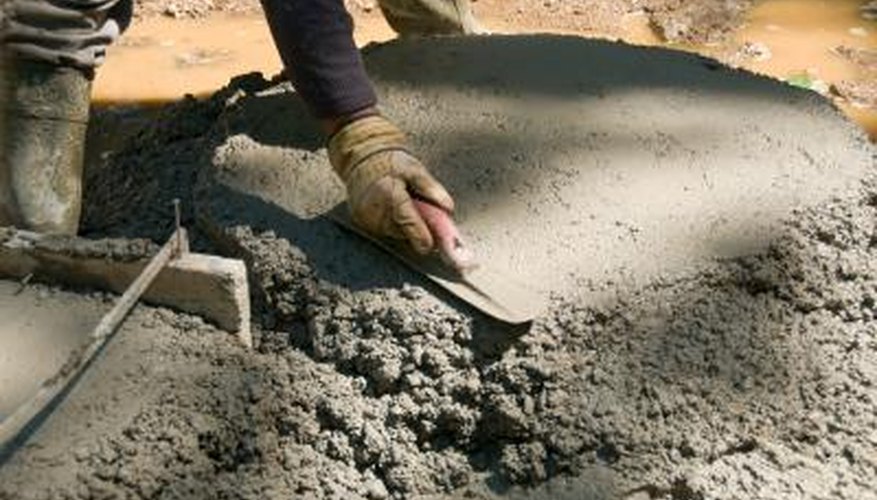Pouring even a small concrete pad is challenging. The proper mix, the proper technique and a lot of hard work are ahead of you on this project. Pouring a circular pad involves creating a round form that has enough bracing to hold the wet concrete in the shape and size you require while the concrete hardens. Once your form is built and the supports are added then the real work begins as you mix, pour and finish your concrete.
Place a piece of rebar in the centre of the area where you want to place the concrete pad. Hold the rebar at a 90-degree angle to the ground. Strike the top end of the rebar with your sledgehammer to drive the metal 12 inches into the ground. Cut a piece of string line half the length of your intended concrete pad. Tie a 1-inch loop in one end of the piece of string. Slide the loop over the rebar in the ground. Tie the free end of the string to your spray paint can. Shake the paint can and stretch out your string to its full length. Walk around the rebar spraying paint onto the ground and keeping the string taut as you go.
- Pouring even a small concrete pad is challenging.
- Slide the loop over the rebar in the ground.
Dig up the turf from inside of your painted circle. Discard the chunks of grass, roots and dirt. Dig a 6-inch trench around the perimeter of your circle with a pick. Unroll your metal trim and stand it up on its side in the trench. Overlap the pieces of trim to complete the circle if necessary. Press the dirt from the trench back into place and compress it with your foot to hold the metal in place. Drive a wooden stake into the ground every 24 inches around the perimeter on the inside of the metal. Drive the stakes into the ground with your sledge hammer, leaving 6 inches of metal above the top of the wooden stakes. Drive a wooden stake every 24 inches around the outside of the metal. Drive the outer stakes so that the top of the wood is flush with the top of the metal.
- Dig up the turf from inside of your painted circle.
- Drive a wooden stake every 24 inches around the outside of the metal.
Fill the inside of your metal circle with gravel. Smooth the surface of the gravel with the point of your shovel. Lay metal concrete cage on top of the gravel. Cut the cage with your tin snips as necessary to fit the circle. Drive a piece of rebar into the gravel every 12 inches in each direction using your sledge hammer. Drive the rebar so that the tops of each stake are 3 inches lower than the top of the metal circle.
- Fill the inside of your metal circle with gravel.
Place cement, sand, gravel and water in the concrete mixer in amounts recommended by the cement manufacturer. Activate the mixer and allow the ingredients to combine and reach a thick, oatmeal-like consistency. Shut off the mixer and shovel the concrete into your circle. Fill the entire circle while stabbing your shovel into the wet concrete to remove air pockets. Rub your float across the top of the concrete pad to smooth the surface. Slide the vertical blade of your edging tool between the metal trim and the wet concrete and push the tool around the perimeter to give the concrete pad a smooth, rounded edge. Allow the concrete to cure for one hour.
Float and edge the concrete pad every hour for 12 hours to keep the surface smooth and maintain your smooth, rounded edge. Cover your finished concrete pad with plastic and leave it to cure for 48 hours. Uncover the concrete pad, pull up the outer stakes and remove the metal form. Allow the concrete to cure for five days before using your new concrete pad.
TIP
This technique can be used for any size pad, no matter how thick. If your metal walls begin to give, you only need to add more stakes along the outer perimeter for support. You can easily adjust the height of the walls of your form by cutting the metal trim with tin snips before setting up your form. Sweep the wet concrete with a stiff bristled broom every hour after your initial floating if your project requires a textured surface for better footing.
WARNING
A concrete mixer is an unforgiving machine. Always use caution around this equipment. Never stick your hands or any tool into a mixer that is running.
